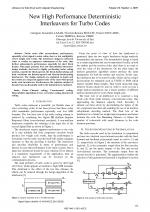| 2/2010 - 22 |
New High Performance Deterministic Interleavers for Turbo CodesLAZAR, G. A. |
| Extra paper information in |
| Click to see author's profile in |
| Download PDF |
Author keywords
channel coding, concatenated coding, deterministic algorithms, error correction coding, interleaved coding
References keywords
turbo(8), codes(6), theory(4), interleavers(4), information(4)
Blue keywords are present in both the references section and the paper title.
About this article
Date of Publication: 2010-05-31
Volume 10, Issue 2, Year 2010, On page(s): 125 - 129
ISSN: 1582-7445, e-ISSN: 1844-7600
Digital Object Identifier: 10.4316/AECE.2010.02022
Web of Science Accession Number: 000280312600022
SCOPUS ID: 77954639592
Abstract
Turbo codes offer extraordinary performance, especially at low signal to noise ratios, due to a low multiplicity of low weight code words. The interleaver design is critical in order to realize an apparent randomness of the code, thus further enhancing its performance, especially for short block frames. This paper presents four new deterministic interleaver design methods, that lead to highly performing turbo coding systems, namely the block-spread, the block-backtracking and their variations the linearly-spread and linearly-backtracking interleavers. The design methods are explained in depth and the results are compared against some of the most wide-spread turbo code interleavers. Furthermore, the selection method of the generator polynomials used in the simulations is explained. |
| References | | | Cited By |
Web of Science® Times Cited: 0
View record in Web of Science® [View]
View Related Records® [View]
Updated today
SCOPUS® Times Cited: 0
View record in SCOPUS® [Free preview]
There are no citing papers in the CrossRef Cited-by Linking system.
Disclaimer: All information displayed above was retrieved by using remote connections to respective databases. For the best user experience, we update all data by using background processes, and use caches in order to reduce the load on the servers we retrieve the information from. As we have no control on the availability of the database servers and sometimes the Internet connectivity may be affected, we do not guarantee the information is correct or complete. For the most accurate data, please always consult the database sites directly. Some external links require authentication or an institutional subscription.
Web of Science® is a registered trademark of Clarivate Analytics, Scopus® is a registered trademark of Elsevier B.V., other product names, company names, brand names, trademarks and logos are the property of their respective owners.
Faculty of Electrical Engineering and Computer Science
Stefan cel Mare University of Suceava, Romania
All rights reserved: Advances in Electrical and Computer Engineering is a registered trademark of the Stefan cel Mare University of Suceava. No part of this publication may be reproduced, stored in a retrieval system, photocopied, recorded or archived, without the written permission from the Editor. When authors submit their papers for publication, they agree that the copyright for their article be transferred to the Faculty of Electrical Engineering and Computer Science, Stefan cel Mare University of Suceava, Romania, if and only if the articles are accepted for publication. The copyright covers the exclusive rights to reproduce and distribute the article, including reprints and translations.
Permission for other use: The copyright owner's consent does not extend to copying for general distribution, for promotion, for creating new works, or for resale. Specific written permission must be obtained from the Editor for such copying. Direct linking to files hosted on this website is strictly prohibited.
Disclaimer: Whilst every effort is made by the publishers and editorial board to see that no inaccurate or misleading data, opinions or statements appear in this journal, they wish to make it clear that all information and opinions formulated in the articles, as well as linguistic accuracy, are the sole responsibility of the author.



